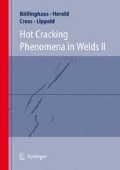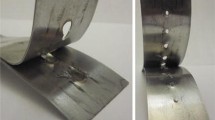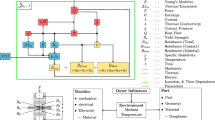Abstract
This study presents how Numerical Simulation, by using the Finite Element Method (FEM), can help to avoid hot cracking phenomena for resistance spot welding of 6xxx AlMgSi alloys. It is well known that aluminum spot welding is a difficult task especially for 6xxx alloys. Small silicon contents in these alloys increase the cracking sensitivity dramatically in comparison with 5xxx alloys. In order to reduce tedious experimental work and to understand such problems SORPAS®, a commercial available Finite Element Method software for resistance welding, was used. Virtual simulation experiments for the innovative resistance spot welding process DELTA SPOT™ led to optimized welding parameters in order to get the desired nugget size without surface cracks.
Chapter PDF
Similar content being viewed by others
Keywords
These keywords were added by machine and not by the authors. This process is experimental and the keywords may be updated as the learning algorithm improves.
References
Stieglbauer W (2006) DeltaSpot – Spot welding with process tape. IIW Doc.III-1381-06
Irving B (2000) The auto industry gears up for aluminum. Welding Journal, 11:63–68
Robson J (2002) Designing high strength aluminum alloys for aerospace applications. Manchester Materials Science Centre.
Krüger U (1994) Weldability. TALAT Lecture 4202, Schweiβtechnische Lehr- und Versuchsanstalt Berlin. EAA – European Aluminium Association.
Senkara J, Zhang H (2000) Cracking in spot welding aluminium alloy AA5754. Welding Journal 7:194–201
Sun X, Stephens EV, Davies RW, Khaleel MA, Spinella DJ (2004) Effects of fusion zone size on failure modes and static strength of aluminum resistance spot welds. Welding Journal 11:308–318
Zhang W (2003) Design and implementation of software for resistance welding process simulations. SAE 2003 World Congress, Detroit, USA
Zhang W (2005) Recent advances and improvements in the simulation of resistance welding processes. IIW Doc.III-1345{\-}05
Wanheim T, Bay N (1987) A model for friction in metal forming processes. Annals of the CIRP 27:189–194
Matthes KJ, Richter E (2006) Schweiβtechnik, Schweiβen von metallischen Konstruktionswerkstoffen. Carl Hanser Verlag München Wien. ISBN-10: 3-446-40568-2
Author information
Authors and Affiliations
Editor information
Editors and Affiliations
Rights and permissions
Copyright information
© 2008 Springer-Verlag Berlin Heidelberg
About this chapter
Cite this chapter
Eder, A., Jaber, S., Jank, N. (2008). Using Simulation for Investigations of Hot Cracking Phenomena in Resistance Spot Welding of 6xxx Aluminum Alloys (AA6016 and AA6181). In: Böllinghaus, T., Herold, H., Cross, C.E., Lippold, J.C. (eds) Hot Cracking Phenomena in Welds II. Springer, Berlin, Heidelberg. https://doi.org/10.1007/978-3-540-78628-3_16
Download citation
DOI: https://doi.org/10.1007/978-3-540-78628-3_16
Publisher Name: Springer, Berlin, Heidelberg
Print ISBN: 978-3-540-78627-6
Online ISBN: 978-3-540-78628-3
eBook Packages: Chemistry and Materials ScienceChemistry and Material Science (R0)




